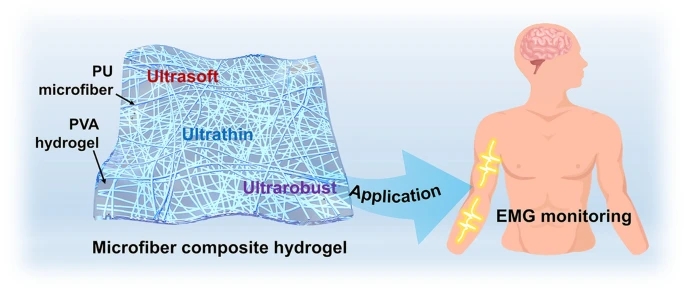文章专利

- 地址: 江苏省苏州市苏州工业园区若水路398号
- 邮箱: tzhang2009@sinano.ac.cn
- 电话: 86-512-62872706
- 传真: 0512-62603079
- 网址: http://nanosensor.sinano.ac.cn

Biological tissue-inspired ultrasoft, ultrathin, and mechanically enhanced microfiber composite hydrogel for flexible bioelectronics, Nano-Micro Letters, 2023, 15: 139.
Qiang Gao; Fuqin Sun; Yue Li; Lianhui Li; Mengyuan Liu; Shuqi Wang; Yongfeng Wang; Tie Li; Lin Liu; Simin Feng; Xiaowei Wang; Seema Agarwal; Ting Zhang*;
Abstract
Hydrogels offer tissue-like softness, stretchability, fracture toughness, ionic conductivity, and compatibility with biological tissues, which make them promising candidates for fabricating flexible bioelectronics. A soft hydrogel film offers an ideal interface to directly bridge thin-film electronics with the soft tissues. However, it remains difficult to fabricate a soft hydrogel film with an ultrathin configuration and excellent mechanical strength. Here we report a biological tissue-inspired ultrasoft microfiber composite ultrathin (< 5 μm) hydrogel film, which is currently the thinnest hydrogel film as far as we know. The embedded microfibers endow the composite hydrogel with prominent mechanical strength (tensile stress ~ 6 MPa) and anti-tearing property. Moreover, our microfiber composite hydrogel offers the capability of tunable mechanical properties in a broad range, allowing for matching the modulus of most biological tissues and organs. The incorporation of glycerol and salt ions imparts the microfiber composite hydrogel with high ionic conductivity and prominent anti-dehydration behavior. Such microfiber composite hydrogels are promising for constructing attaching-type flexible bioelectronics to monitor biosignals.

URL: https://link.springer.com/article/10.1007/s40820-023-01096-4
